Quantifying Climate Change and Ecological Responses within the Yangtze River Basin, China
Abstract
1. Introduction
2. Materials and Methods
2.1. Study Area
2.2. Data Sources and Processing
2.2.1. Climate Datasets
2.2.2. Simulations of Temperature and Precipitation Data Using World Climate Research Programme (WCRP) Climate Model Intercomparison Project (CMIP5) Multiple Climate Models
2.2.3. Moderate Resolution Imaging Spectroradiometer (MODIS) Normalized Difference Vegetation Index/Enhanced Vegetation Index (NDVI/EVI)
2.2.4. Advanced Very High-Resolution Radiometer (AVHRR) at Boston University (BU) generated the Leaf Area Index (LAI)
2.2.5. MODIS Gross Primary Production/Net Primary Production (GPP/NPP)
2.3. Methodology
3. Results
3.1. Trends of the Climatic Parameters in the Yangtze River Basin (YRB) during 1961–2013
3.2. Trends in Ecological Indicators in the YRB
3.3. Correlations between Climatic Variations and Ecological Indicators
4. Discussion
5. Conclusions
Author Contributions
Funding
Conflicts of Interest
Appendix A
| Climate Parameters | Ecological Indicators | R2 | Sig |
|---|---|---|---|
| Temperature (Controlled Precipitation) | Annual mean NDVI | 0.37 * | 0.037 |
| Mean EVI in growing season | 0.37 * | 0.035 | |
| Annual mean LAI | 0.35 ** | 0.001 | |
| Annual GPP | 0.40 * | 0.049 | |
| Annual NPP | 0.41 * | 0.044 | |
| Precipitation (Controlled Temperature) | Annual mean NDVI | 0.01 | 0.776 |
| Mean EVI in growing season | 0.19 | 0.158 | |
| Annual mean LAI | 0.00 | 0.799 | |
| Annual GPP | 0.06 | 0.491 | |
| Annual NPP | 0.21 | 0.187 |
References
- Gang, C.; Zhang, Y.; Wang, Z.; Chen, Y.; Yang, Y.; Li, J.; Cheng, J.; Qi, J.; Odeh, I. Modeling the dynamics of distribution, extent, and NPP of global terrestrial ecosystems in response to future climate change. Glob. Planet. Chang. 2017, 148, 153–165. [Google Scholar] [CrossRef]
- Cao, M.; Woodward, F.L. Dynamic responses of terrestrial ecosystem carbon cycling to global climate change. Nature 1998, 393, 249–252. [Google Scholar] [CrossRef]
- Qin, D.; Stocker, T. Highlights of the IPCC Working Group I Fifth Assessment Report. Prog. Inquisitions Mutat. Clim. 2014, 10, 1–6. [Google Scholar]
- Zhang, Q.; Zhao, D.; Hong, W.; Dai, E. Research on Vegetation Changes and Influence Factors Based of Eco-geographical Regions of Inner Mongolia. Sci. Geogr. Sin. 2013, 33, 594–601. [Google Scholar]
- Yue, T.; Fan, Z. A review of responses of typical terrestrial ecosystems to climate change. Chin. Sci. Bull. 2014, 59, 217–231. [Google Scholar] [CrossRef]
- Zhu, Z.; Piao, S.; Myneni, R.B.; Huang, M.; Zeng, Z.; Canadell, J.G.; Ciais, P.; Sitch, S.; Friedlingstein, P.; Arneth, A.; et al. Greening of the Earth and its drivers. Nat. Clim. Chang. 2016, 6, 791–795. [Google Scholar] [CrossRef]
- Yuan, Q.; Wu, S.; Dai, E.; Zhao, D.; Ren, P.; Zhang, X. NPP vulnerability of the potential vegetation of China to climate change in the past and future. J. Geogr. Sci. 2017, 27, 131–142. [Google Scholar] [CrossRef]
- Piao, S.; Ciais, P.; Huang, Y.; Shen, Z.; Peng, S.; Li, J.; Zhou, L.; Liu, H.; Ma, Y.; Ding, Y.; et al. The impacts of climate change on water resources and agriculture in China. Nature 2010, 467, 43–51. [Google Scholar] [CrossRef] [PubMed]
- Reich, P.B.; Sendall, K.M.; Stefanski, A.; Wei, X.; Rich, R.L.; Montgomery, R.A. Boreal and temperate trees show strong acclimation of respiration to warming. Nature 2016, 531, 633–636. [Google Scholar] [CrossRef] [PubMed]
- Fang, J.; Piao, S.; Tang, Z.; Peng, C.; Ji, W. Interannual Variability in Net Primary Production and Precipitation Science. Science 2001, 293, 1723. [Google Scholar] [CrossRef] [PubMed]
- Behrenfeld, M.J.; Randerson, J.T.; Mcclain, C.R.; Feldman, G.C.; Los, S.O.; Tucker, C.J.; Falkowski, P.G.; Field, C.B.; Frouin, R.; Esaias, W.E. Biospheric Primary Production during an ENSO Transition. Science 2001, 291, 2594–2597. [Google Scholar] [CrossRef] [PubMed]
- Running, S.W.; Thornton, P.E.; Nemani, R.; Glassy, J.M. Global Terrestrial Gross and Net Primary Productivity from the Earth Observing System; Springer: New York, NY, USA, 2000. [Google Scholar]
- Kleidon, A. The climate sensitivity to human appropriation of vegetation productivity and its thermodynamic characterization. Glob. Planet. Chang. 2006, 54, 109–127. [Google Scholar] [CrossRef]
- Spano, D.; Cesaraccio, C.; Duce, P.; Snyder, R.L. Phenological stages of natural species and their use as climate indicators. Int. J. Biometeorol. 1999, 42, 124–133. [Google Scholar] [CrossRef]
- Zhang, X.; Friedl, M.A.; Schaaf, C.B.; Strahler, A.H. Climate controls on vegetation phenological patterns in northern mid- and high latitudes inferred from MODIS data. Glob. Chang. Biol. 2004, 10, 1133–1145. [Google Scholar] [CrossRef]
- Munir, T.M.; Perkins, M.; Kaing, E.; Strack, M. Carbon dioxide flux and net primary production of a boreal treed bog: Responses to warming and water table manipulations. Biogeosci. Discuss. 2014, 11, 12937–12983. [Google Scholar] [CrossRef]
- Jenny, H. Factors of Soil Formation: A System of Quantitative Pedology; The Maple Press Company: York, PA, USA, 1941. [Google Scholar]
- Jenny, H. The Soil Resource—Origin and Behavior. Ecological Studies 37; Springer-Verlag New York, Inc.: New York, NY, USA, 1984. [Google Scholar]
- Davidson, E.A.; Janssens, I.A. Temperature sensitivity of soil carbon decomposition and feedbacks to climate change. Nature 2006, 440, 165–173. [Google Scholar] [CrossRef] [PubMed]
- Kirschbaum, M.U.F. Will changes in soil organic carbon act as a positive or negative feedback on global warming? Biogeochemistry 2000, 48, 21–51. [Google Scholar] [CrossRef]
- Fang, S.; Yan, J.; Che, M.; Zhu, Y.; Liu, Z.; Pei, H.; Zhang, H.; Xu, G.; Lin, X. Climate change and the ecological responses in Xinjiang, China: Model simulations and data analyses. Quat. Int. 2013, 311, 108–116. [Google Scholar] [CrossRef]
- Hao, L.; Pan, C.; Liu, P.; Zhou, D.; Zhang, L.; Xiong, Z.; Liu, Y.; Sun, G. Detection of the Coupling between Vegetation Leaf Area and Climate in a Multifunctional Watershed, Northwestern China. Remote Sens. 2016, 8, 1032. [Google Scholar] [CrossRef]
- Liang, W.; Yang, Y.; Fan, D.; Guan, H.; Zhang, T.; Long, D.; Zhou, Y.; Bai, D. Analysis of spatial and temporal patterns of net primary production and their climate controls in China from 1982 to 2010. Agric. For. Meteorol. 2015, 204, 22–36. [Google Scholar] [CrossRef]
- Huang, K.; Zhang, Y.; Zhu, J.; Liu, Y.; Zu, J.; Zhang, J. The Influences of Climate Change and Human Activities on Vegetation Dynamics in the Qinghai-Tibet Plateau. Remote Sens. 2016, 8, 876. [Google Scholar] [CrossRef]
- Zhou, D.; Zhao, S.; Zhang, L.; Liu, S. Remotely sensed assessment of urbanization effects on vegetation phenology in China’s 32 major cities. Remote Sens. Environ. 2016, 176, 272–281. [Google Scholar] [CrossRef]
- Zhang, Y.; Song, C.; Zhang, K.; Cheng, X.; Band, L.E.; Zhang, Q. Effects of land use/land cover and climate changes on terrestrial net primary productivity in the Yangtze River Basin, China, from 2001 to 2010. J. Geophys. Res. Biogeosci. 2014, 116, 1092–1109. [Google Scholar] [CrossRef]
- Qu, S.; Wang, L.; Lin, A.; Zhu, H.; Yuan, M. What drives the vegetation restoration in Yangtze River basin, China: Climate change or anthropogenic factors? Ecol. Indic. 2018, 90, 438–450. [Google Scholar] [CrossRef]
- Commission, Y.R.W.R. Atlas of the Yangtze River Basin; The Sino Maps Press: Beijing, China, 1999. [Google Scholar]
- Tang, C.; Sun, W. Comprehensive evaluation of land spatial development suitability of the Yangtze River Basin. Acta Geogr. Sin. 2012, 67, 1587–1598. [Google Scholar]
- Kai, G.; Zhou, Z.; Yang, Y. Land use structure and its spatial autocorrelation analysis in the Yangtze River Basin. Resour. Environ. Yangtze Basin 2010, 19, 13–20. [Google Scholar]
- Ke, J.; Piao, S.; Fang, J. NPP and its spatiotemporal Patterns in the Yangtze River Watershed. Acta Phytoecol. Sin. 2003, 27, 764–770. [Google Scholar]
- Lin, A.; Zhu, H.; Wang, L.; Gong, W.; Zou, L. Characteristics of Long-Term Climate Change and the Ecological Responses in Central China. Earth Interact. 2016, 20, 1–24. [Google Scholar] [CrossRef]
- Pan, Z.; Zhang, Y.; Liu, X.; Gao, Z. Current and future precipitation extremes over Mississippi and Yangtze River basins as simulated in CMIP5 models. J. Earth Sci. China 2016, 27, 22–36. [Google Scholar] [CrossRef]
- Kimball, J.S.; Zhao, M.; Mcguire, A.D.; Heinsch, F.A.; Clein, J.; Calef, M.; Jolly, W.M.; Kang, S.; Euskirchen, S.E.; Mcdonald, K.C. Recent Climate-Driven Increases in Vegetation Productivity for the Western Arctic: Evidence of an Acceleration of the Northern Terrestrial Carbon Cycle. Earth Interact. 2007, 11, 4. [Google Scholar] [CrossRef]
- Zhu, Z.; Bi, J.; Pan, Y.; Ganguly, S.; Anav, A.; Xu, L.; Samanta, A.; Piao, S.; Nemani, R.; Myneni, R. Global Data Sets of Vegetation Leaf Area Index (LAI)3g and Fraction of Photosynthetically Active Radiation (FPAR)3g Derived from Global Inventory Modeling and Mapping Studies (GIMMS) Normalized Difference Vegetation Index (NDVI3g) for the Period 1981 to 2011. Remote Sens. 2013, 5, 927–948. [Google Scholar]
- Brassel, K.E.; Reif, D. A Procedure to Generate Thiessen Polygons. Geogr. Anal. 1979, 11, 289–303. [Google Scholar] [CrossRef]
- Powell, M.J.D. Radial basis functions for multivariable interpolation: A review. In Algorithms for Approximation; Clarendon Press: New York, NY, USA, 1987; pp. 143–167. [Google Scholar]
- Oliver, M.; Webster, R. Kriging: A method of interpolation for geographical information systems. Int. J. Geogr. Inf. Syst. 1990, 4, 313–332. [Google Scholar] [CrossRef]
- Lu, G.Y.; Wong, D.W. An adaptive inverse-distance weighting spatial interpolation technique. Comput. Geosci. 2008, 34, 1044–1055. [Google Scholar] [CrossRef]
- Krajewski, W.F. Co-Kriging of Radar-Rainfall and Rain Gauge Data. J. Geophys. Res. Atmos. 1987, 92, 9571–9580. [Google Scholar] [CrossRef]
- Del, G.S.; Parton, W.; Stohlgren, T.; Zheng, D.; Bachelet, D.; Prince, S.; Hibbard, K.; Olson, R. Global potential net primary production predicted from vegetation class, precipitation, and temperature. Ecology 2008, 89, 2117–2126. [Google Scholar]
- ConG, N.; Shen, M.; Piao, S. Spatial variations in responses of vegetation autumn phenology to climate change on the Tibetan Plateau. J. Plant Ecol. 2017, 10, 744–752. [Google Scholar] [CrossRef]
- Chatfield, C. The analysis of time series: An introduction/C. Chatfield. Technometrics 1991, 33, 363–364. [Google Scholar]
- Wang, Q.; Zhang, M.; Wang, S. Extreme temperature events in Yangtze River Basin during 1962–2011. J. Geogr. Sci. 2014, 24, 59–75. [Google Scholar] [CrossRef]
- Fasano, G.; Franceschini, A. A multidimensional version of the Kolmogorov–Smirnov test. Mon. Not. R. Astron. Soc. 1987, 225, 9–20. [Google Scholar] [CrossRef]
- Zhao, A.; Zhang, A.; Liu, X.; Cao, S. Spatiotemporal changes of normalized difference vegetation index (NDVI) and response to climate extremes and ecological restoration in the Loess Plateau, China. Theor. Appl. Climatol. 2018, 132, 555–567. [Google Scholar] [CrossRef]
- Lenihan, J.M.; Bachelet, D.; Neilson, R.P.; Drapek, R. Response of vegetation distribution, ecosystem productivity, and fire to climate change scenarios for California. Clim. Chang. 2008, 87, 215–230. [Google Scholar] [CrossRef]
- An, C.; Fan, J.; Zhang, Y.; Yan, D. Characterizing the responses of vegetation to climate change in the Tibet Plateau using remote sensing data. J. Appl. Remote Sens. 2018, 12, 016035. [Google Scholar] [CrossRef]
- Yao, R.; Wang, L.; Gui, X.; Zheng, Y.; Zhang, H.; Huang, X. Urbanization Effects on Vegetation and Surface Urban Heat Islands in China’s Yangtze River Basin. Remote Sens. 2017, 9, 540. [Google Scholar] [CrossRef]
- Kazak, J. The Use of a Decision Support System for Sustainable Urbanization and Thermal Comfort in Adaptation to Climate Change Actions—The Case of the Wrocław Larger Urban Zone (Poland). Sustainability 2018, 10, 1083. [Google Scholar] [CrossRef]
- Sun, Y.; Yang, Y.; Zhang, L.; Wang, Z. The relative roles of climate variations and human activities in vegetation change in North China. Phys. Chem. Earth Parts A/B/C 2015, 87–88, 67–78. [Google Scholar] [CrossRef]
- Miao, L.; Liu, Q.; Fraser, R.; He, B.; Cui, X. Shifts in vegetation growth in response to multiple factors on the Mongolian Plateau from 1982 to 2011. Phys. Chem. Earth Parts A/B/C 2015, 87–88, 50–59. [Google Scholar] [CrossRef]
- Piao, S.; Mohammat, A.; Fang, J.; Cai, Q.; Feng, J. NDVI-based increase in growth of temperate grasslands and its responses to climate changes in China. Glob. Environ. Chang. 2006, 16, 340–348. [Google Scholar] [CrossRef]
- Jiang, L.; Jiapaer, G.; Bao, A.; Guo, H.; Ndayisaba, F. Vegetation dynamics and responses to climate change and human activities in Central Asia. Sci. Total Environ. 2017, 599–600, 967–980. [Google Scholar] [CrossRef] [PubMed]
- Qu, B.; Zhu, W.; Jia, S.; Lv, A. Spatio-Temporal Changes in Vegetation Activity and Its Driving Factors during the Growing Season in China from 1982 to 2011. Remote Sens. 2015, 7, 13729–13752. [Google Scholar] [CrossRef]
- Tong, S.; Zhang, J.; Bao, Y.; Lai, Q.; Xiao, L.; Li, N.; Bao, Y. Analyzing vegetation dynamic trend on the Mongolian Plateau based on the Hurst exponent and influencing factors from 1982–2013. J. Geogr. Sci. 2018, 28, 595–610. [Google Scholar] [CrossRef]
- Wang, J.; Wang, K.; Zhang, M.; Zhang, C. Impacts of climate change and human activities on vegetation cover in hilly southern China. Ecol. Eng. 2015, 81, 451–461. [Google Scholar] [CrossRef]
- Wen, Z.; Wu, S.; Chen, J.; Lü, M. NDVI indicated long-term interannual changes in vegetation activities and their responses to climatic and anthropogenic factors in the Three Gorges Reservoir Region, China. Sci. Total Environ. 2017, 574, 947–959. [Google Scholar] [CrossRef] [PubMed]
- Li, S.; Yang, S.; Liu, X.; Liu, Y.; Shi, M. NDVI-Based Analysis on the Influence of Climate Change and Human Activities on Vegetation Restoration in the Shaanxi-Gansu-Ningxia Region, Central China. Remote Sens. 2015, 7, 11163–11182. [Google Scholar] [CrossRef]

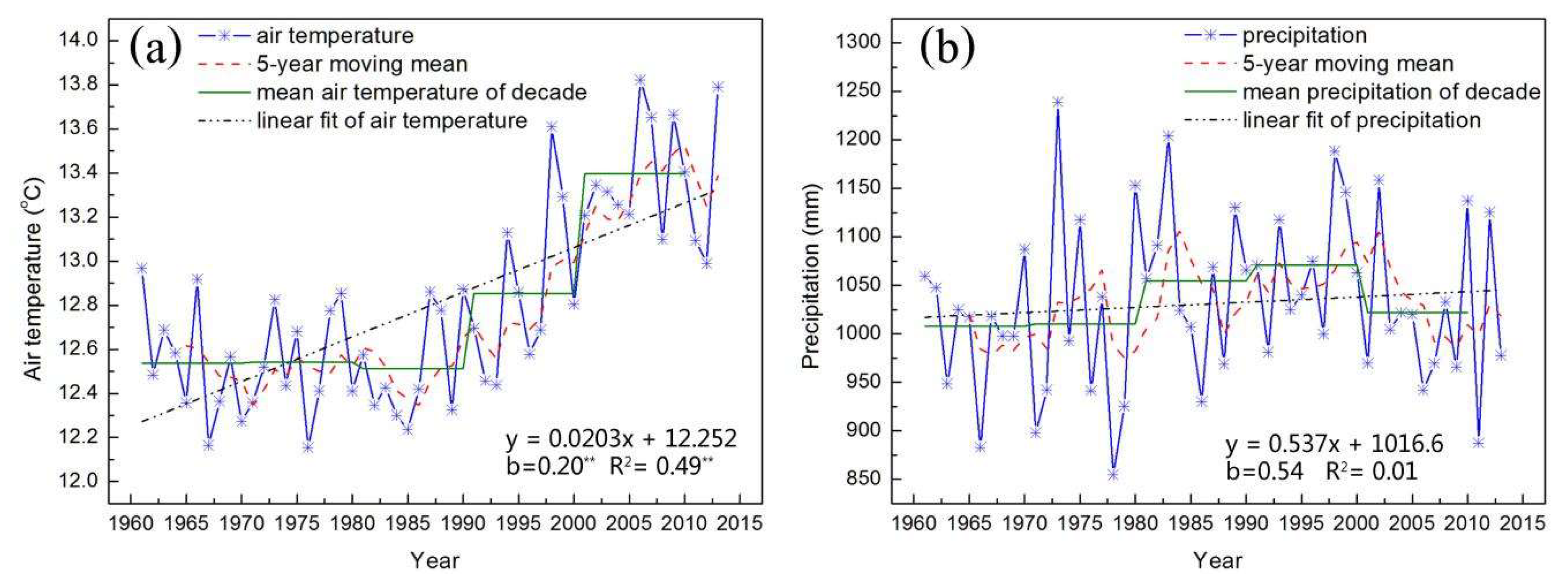
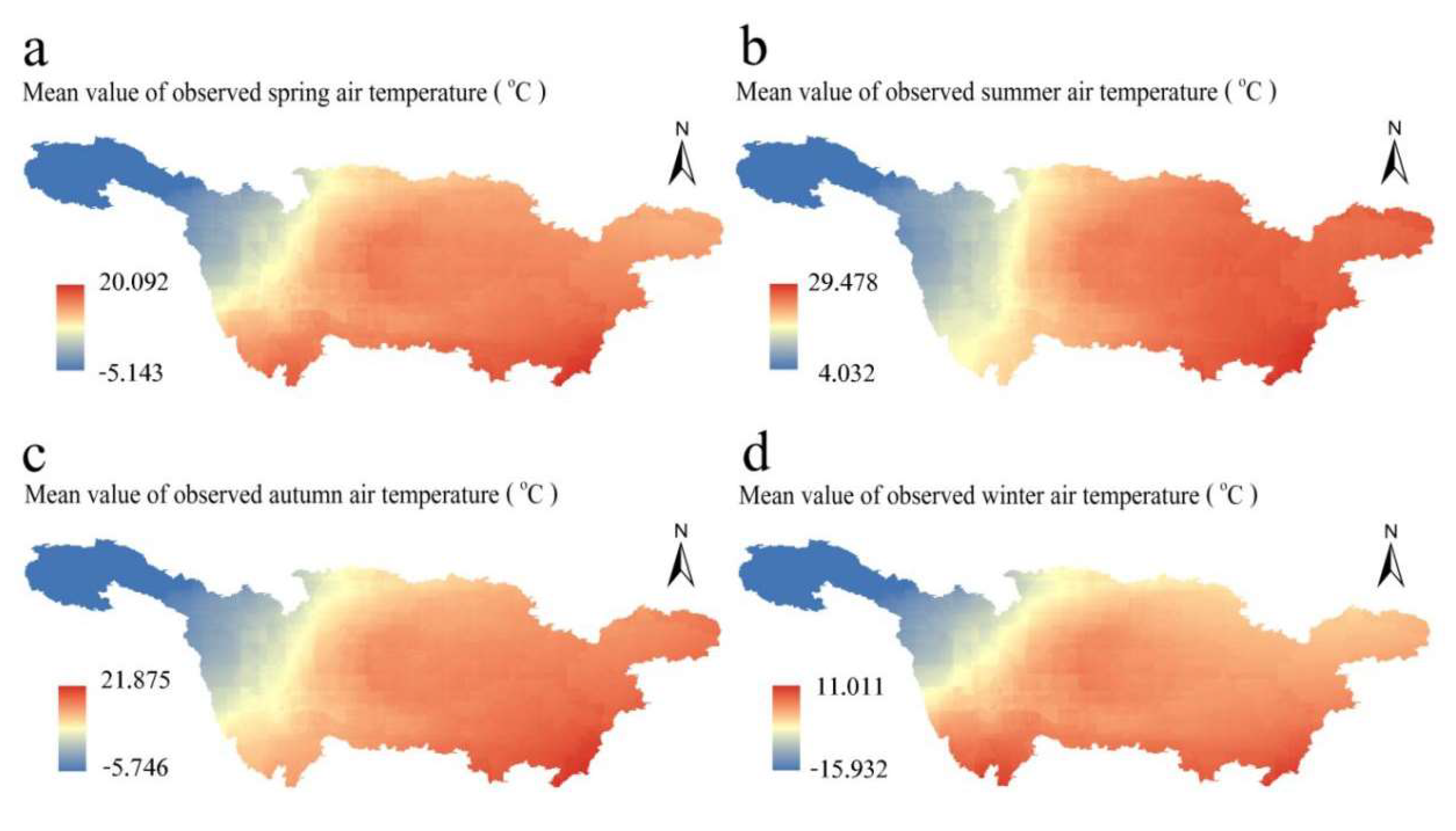
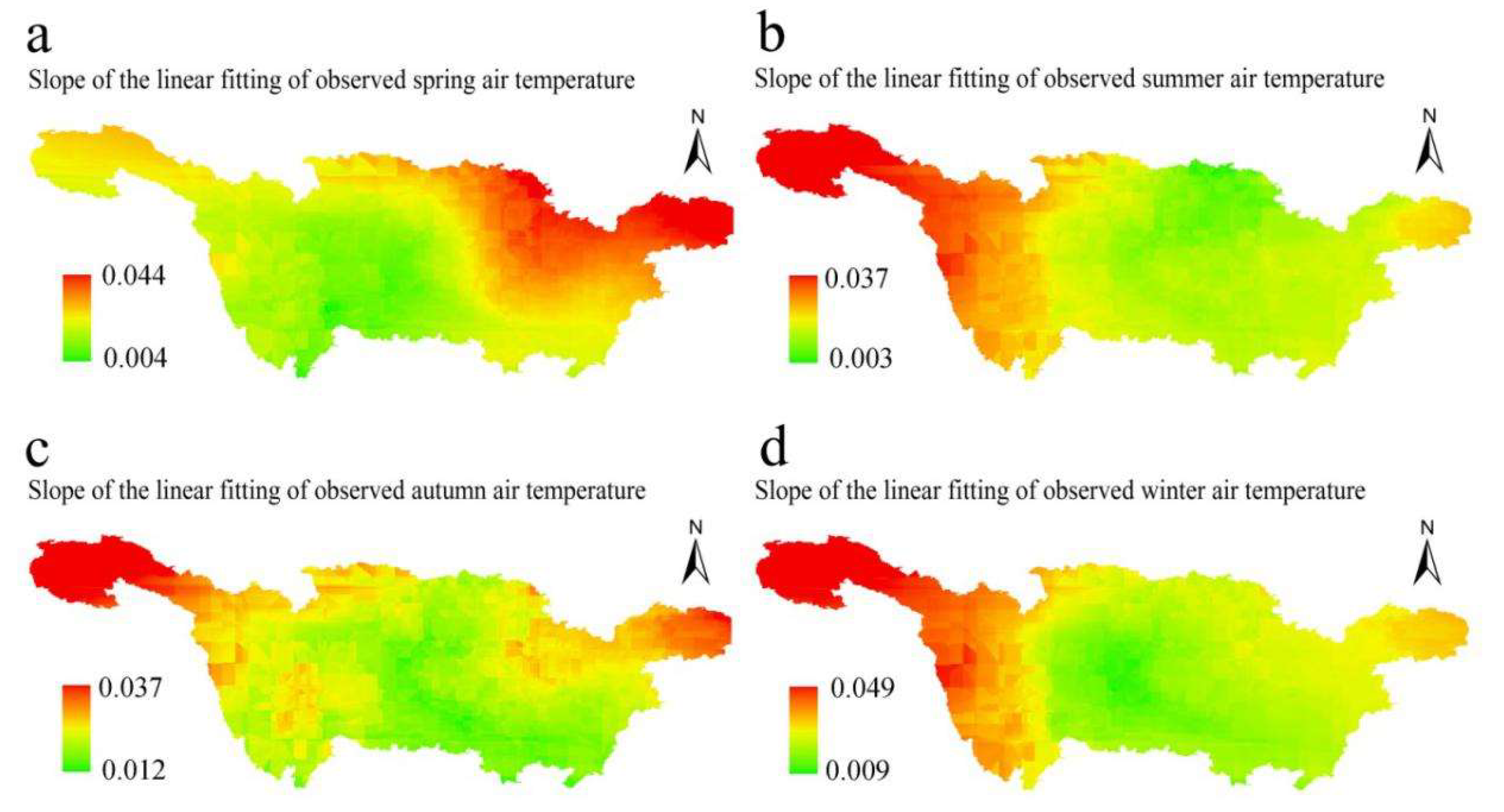
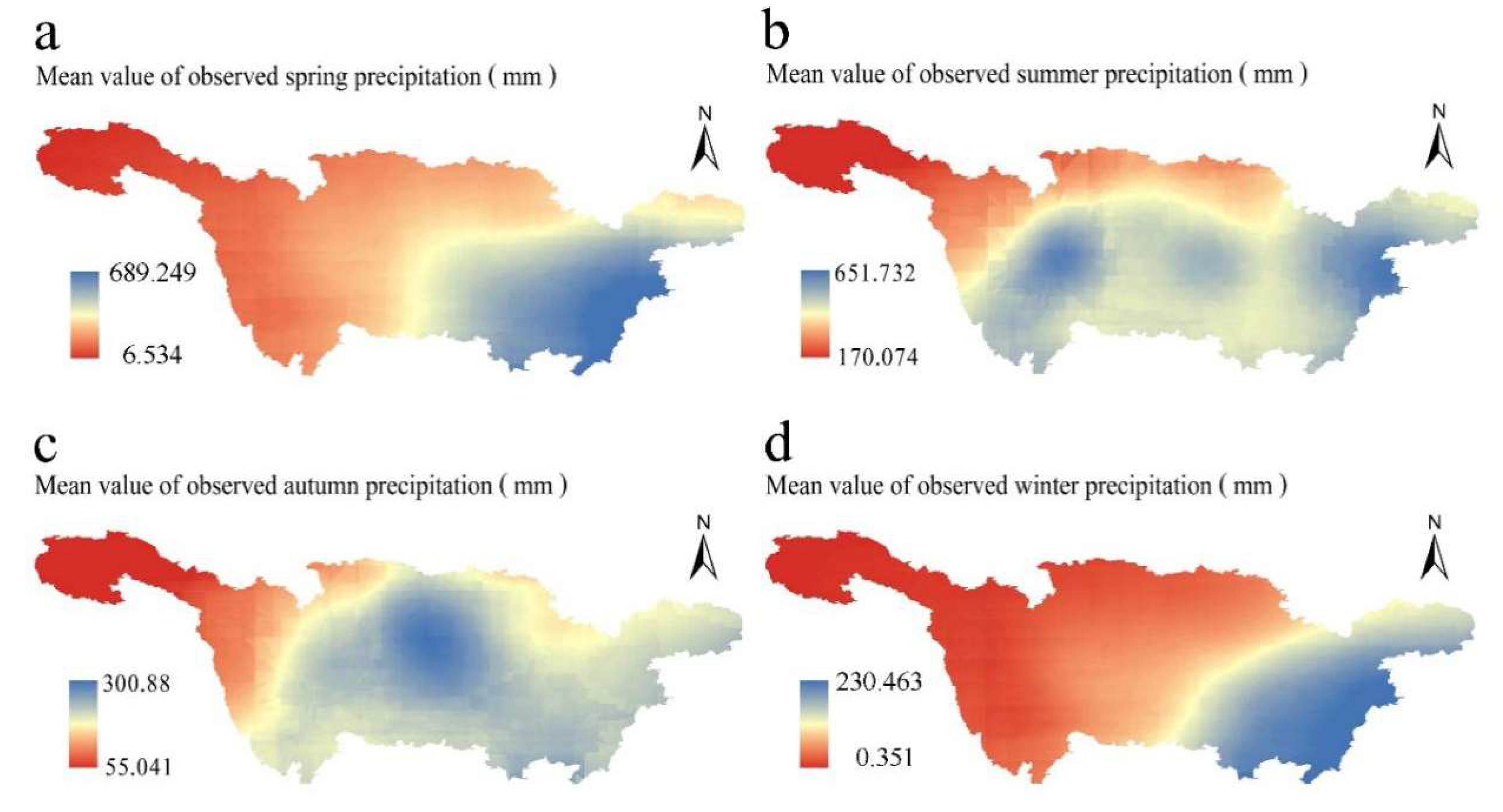
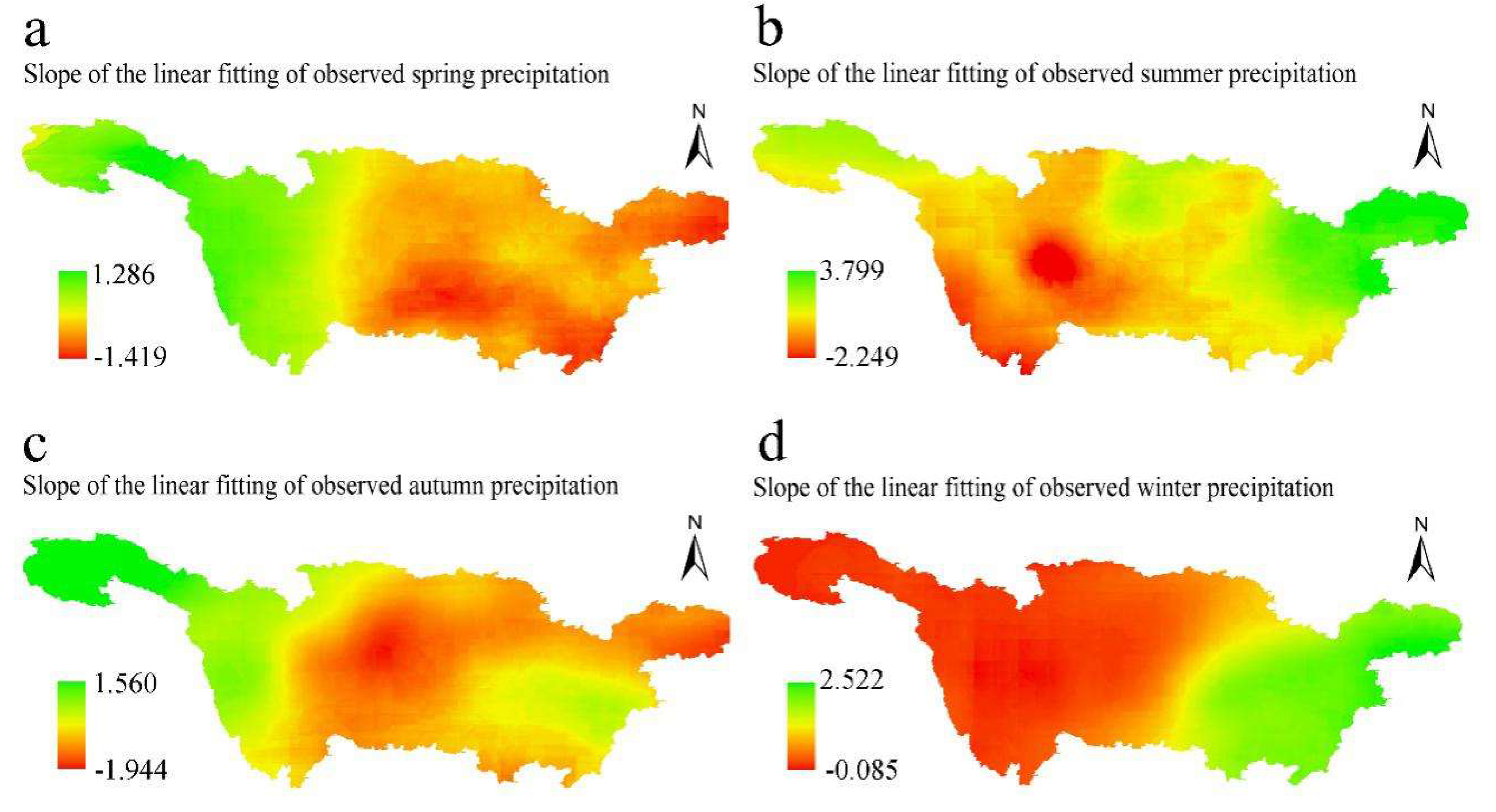
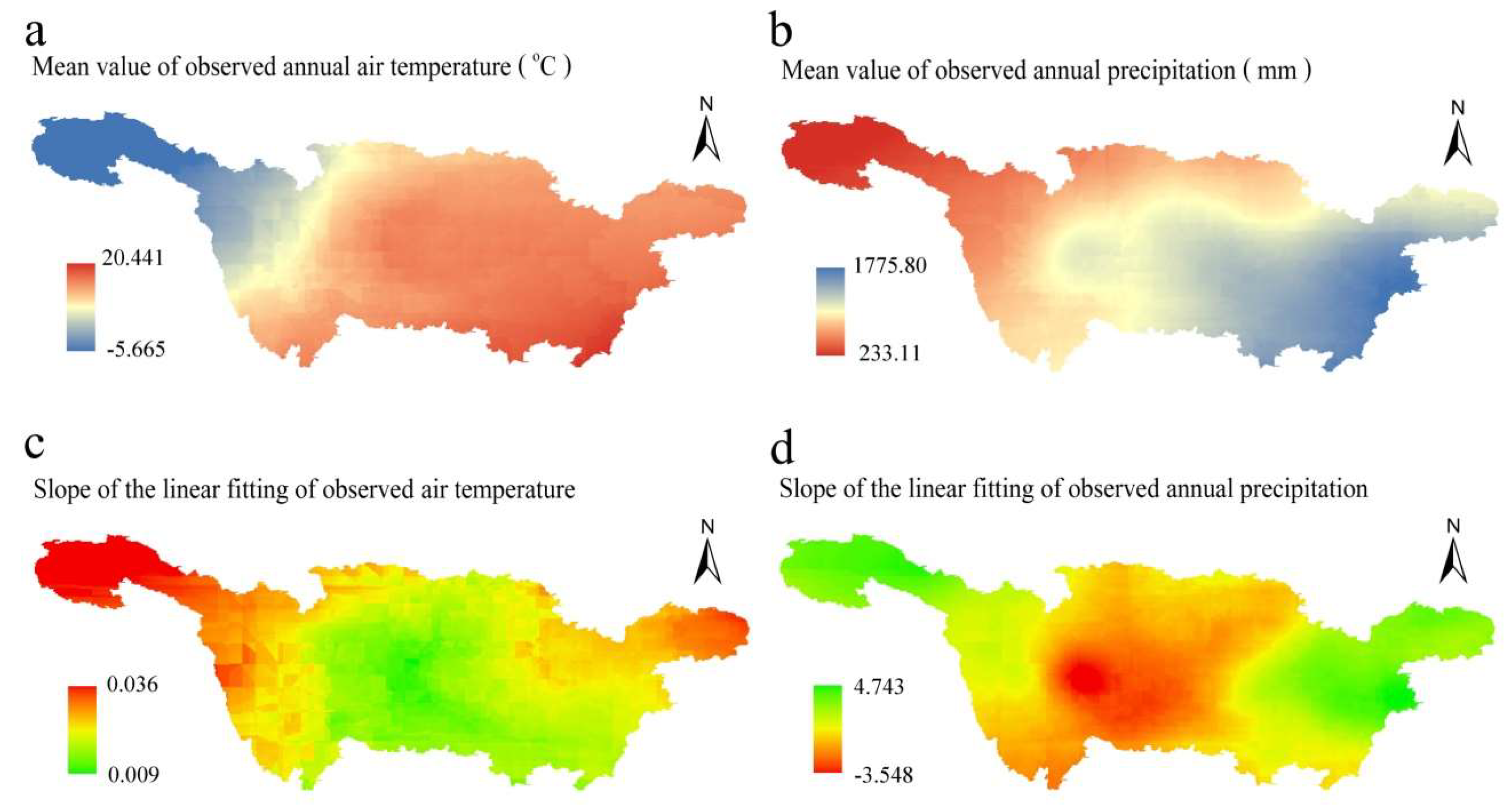
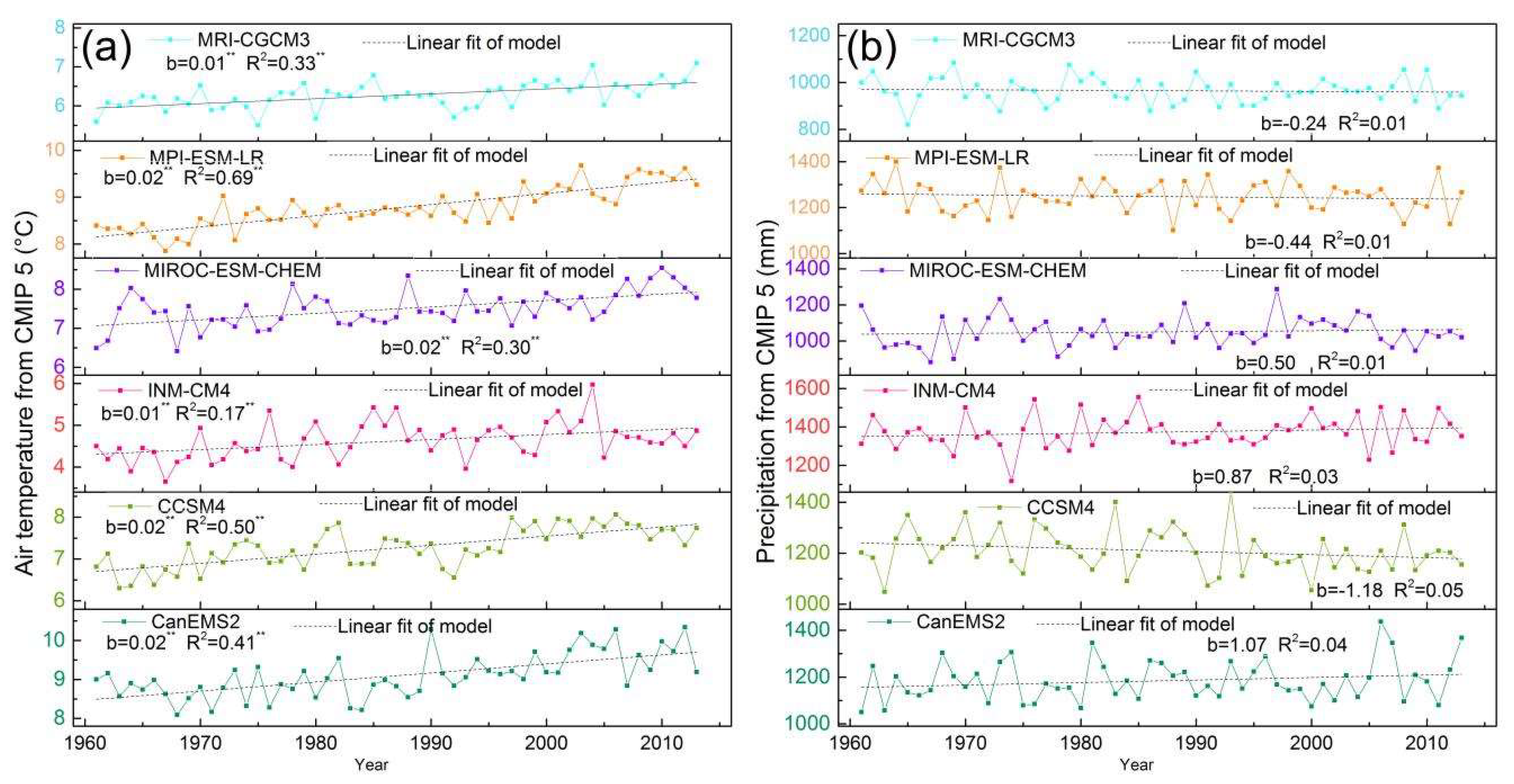


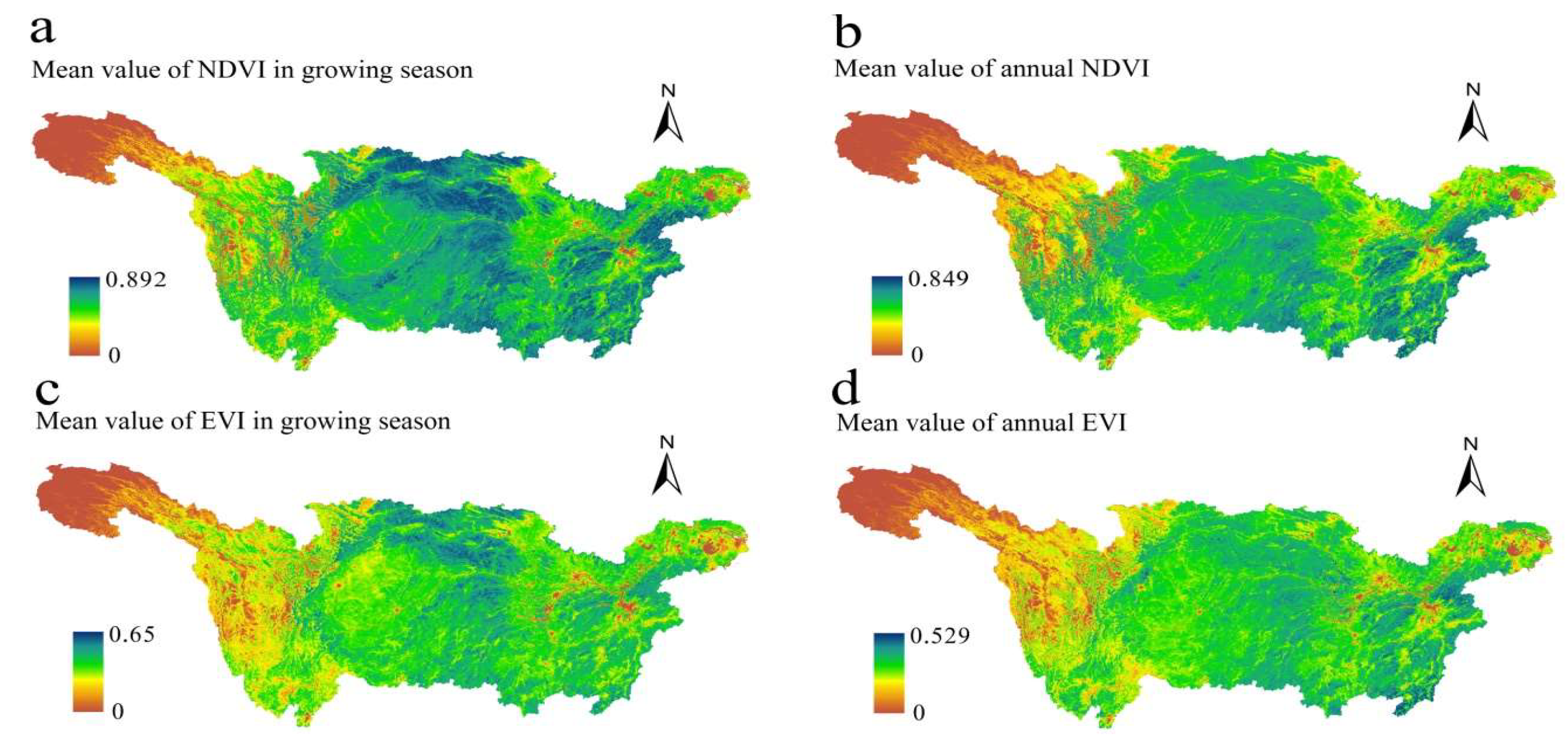
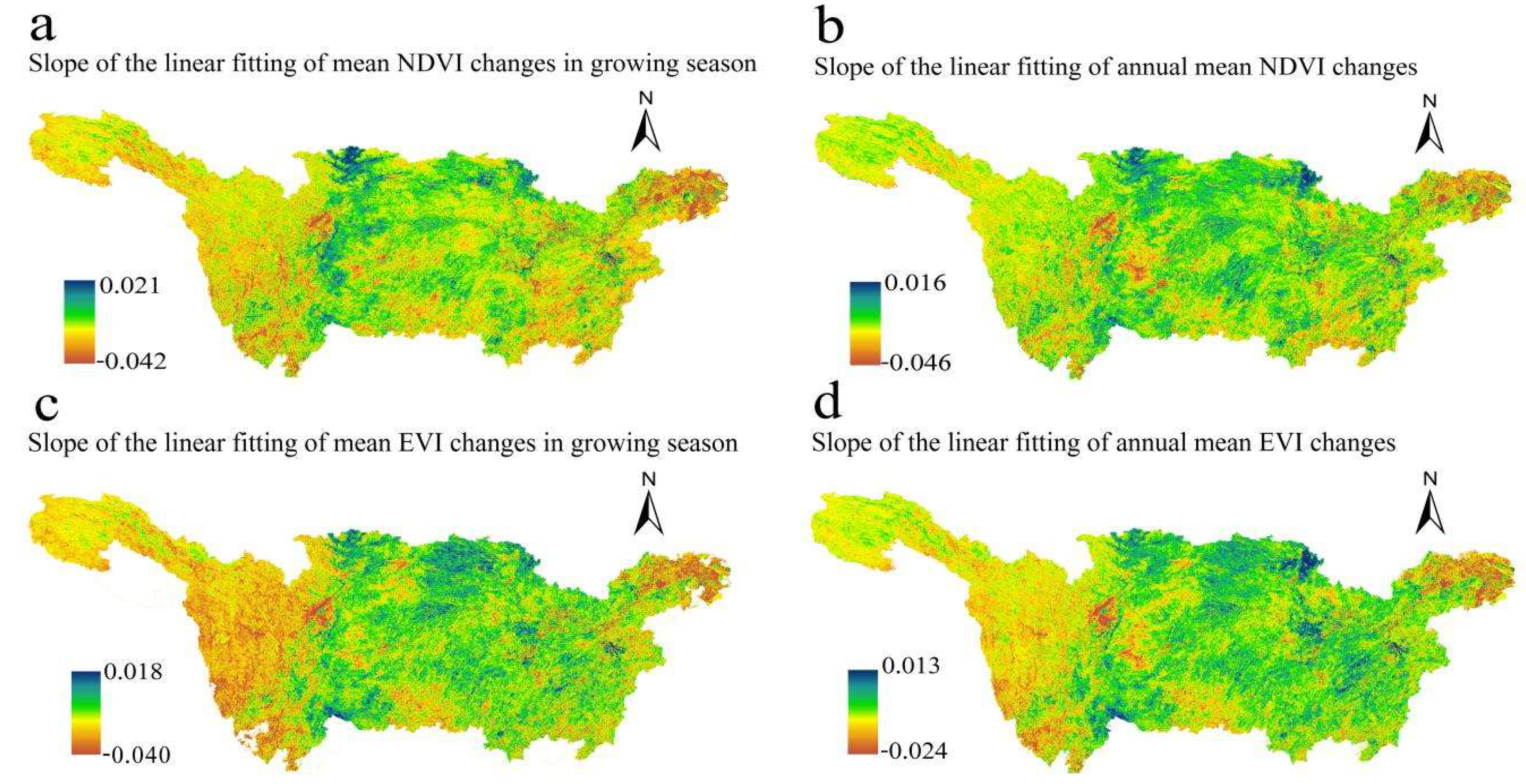

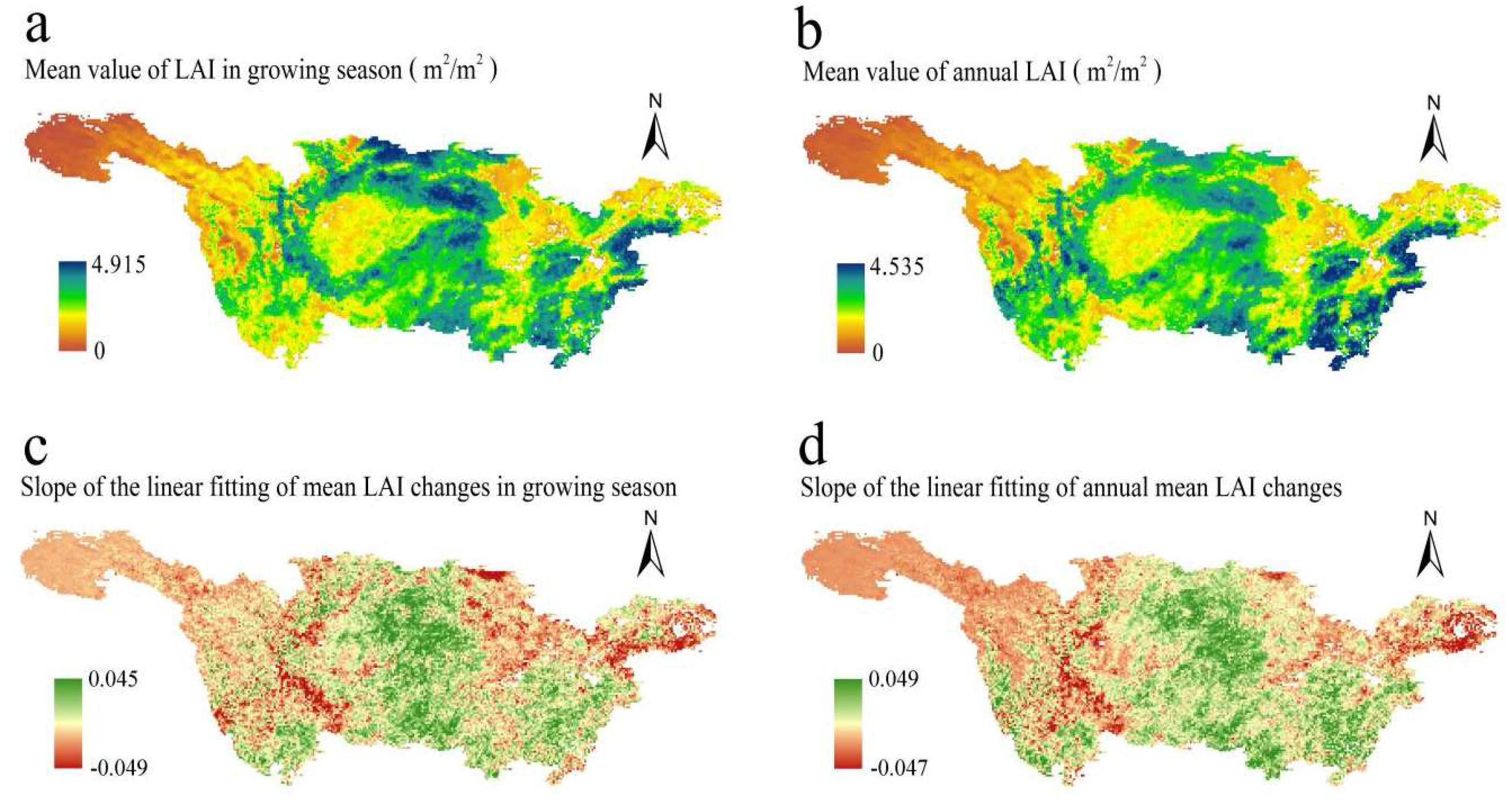
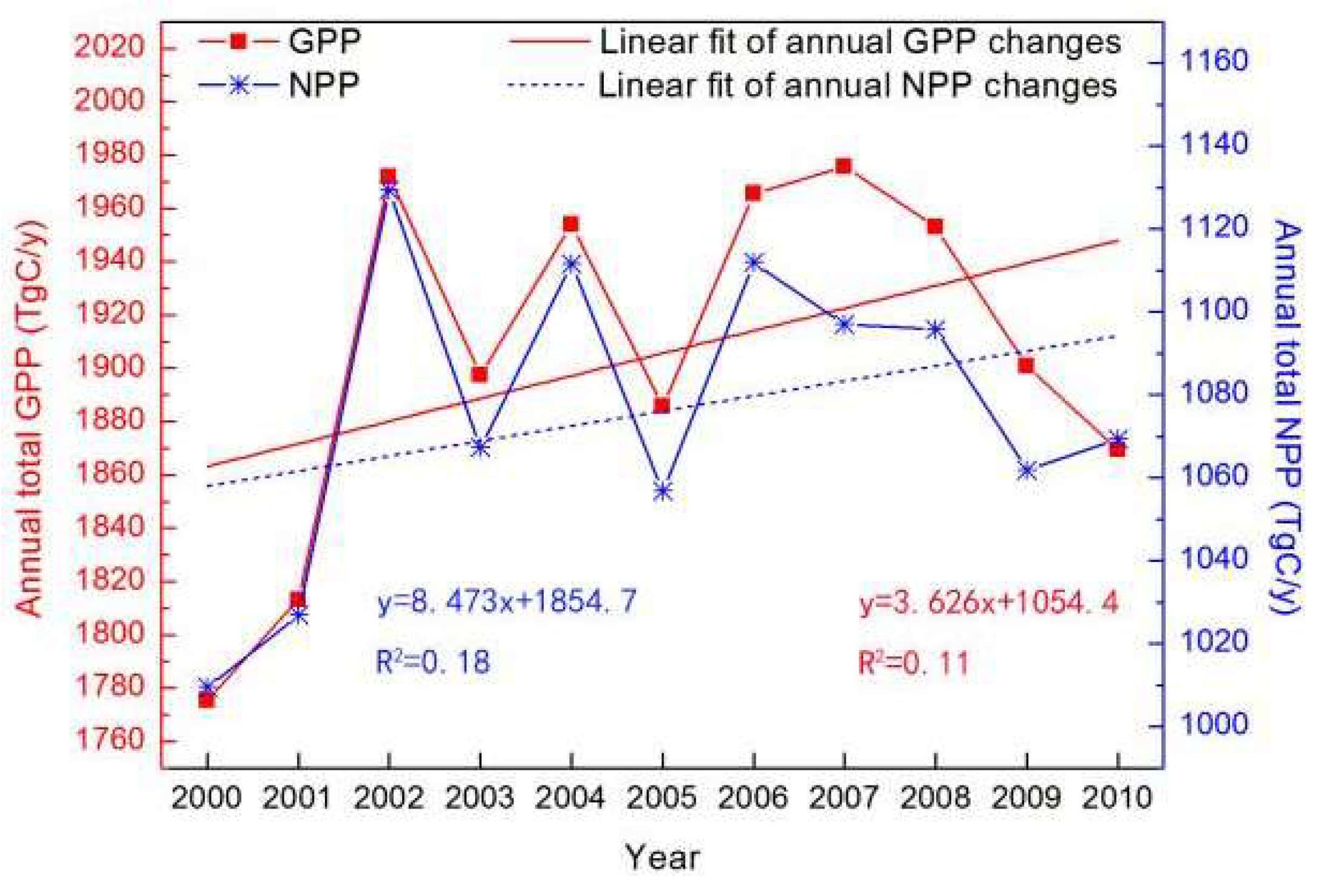
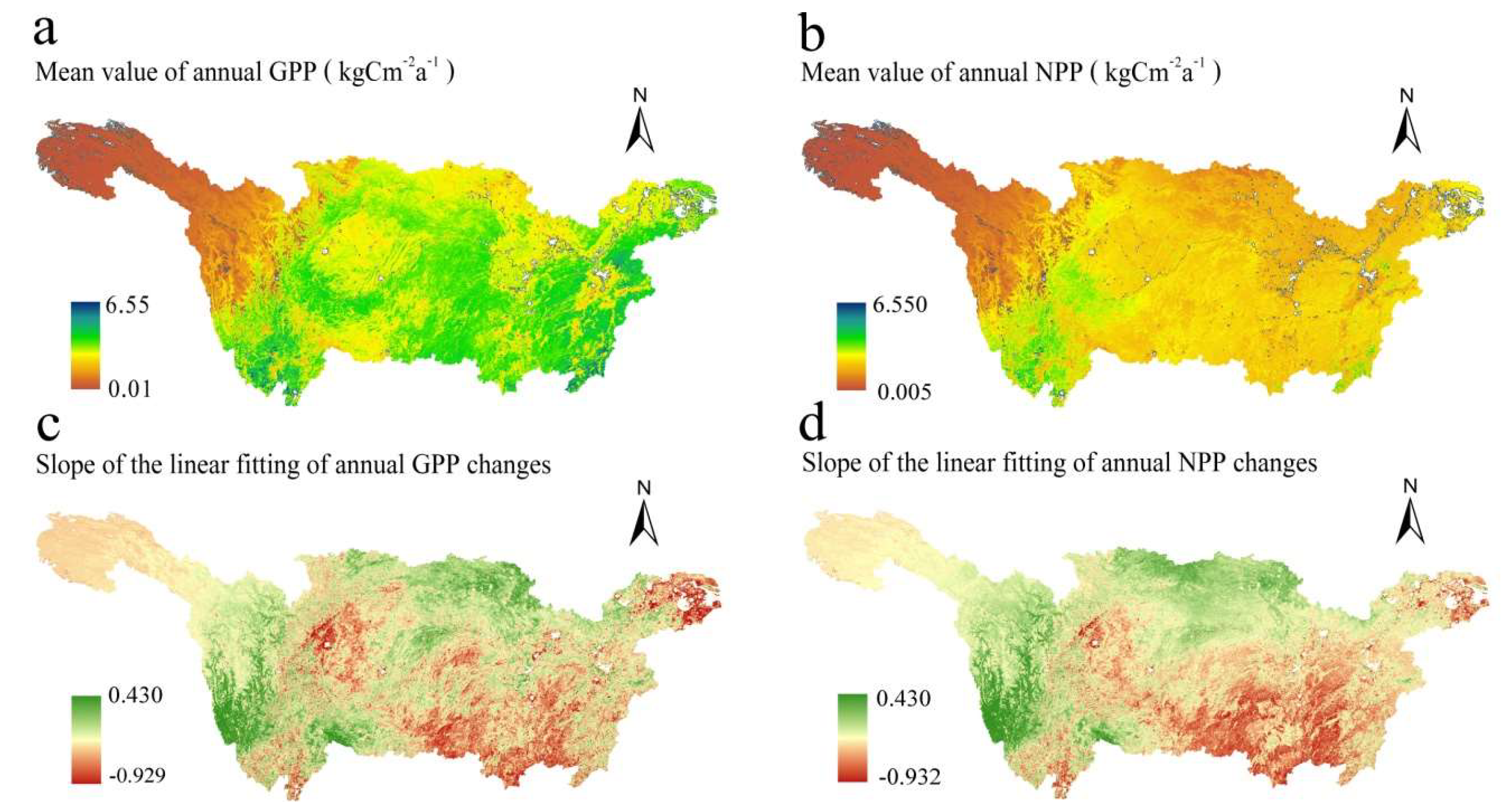
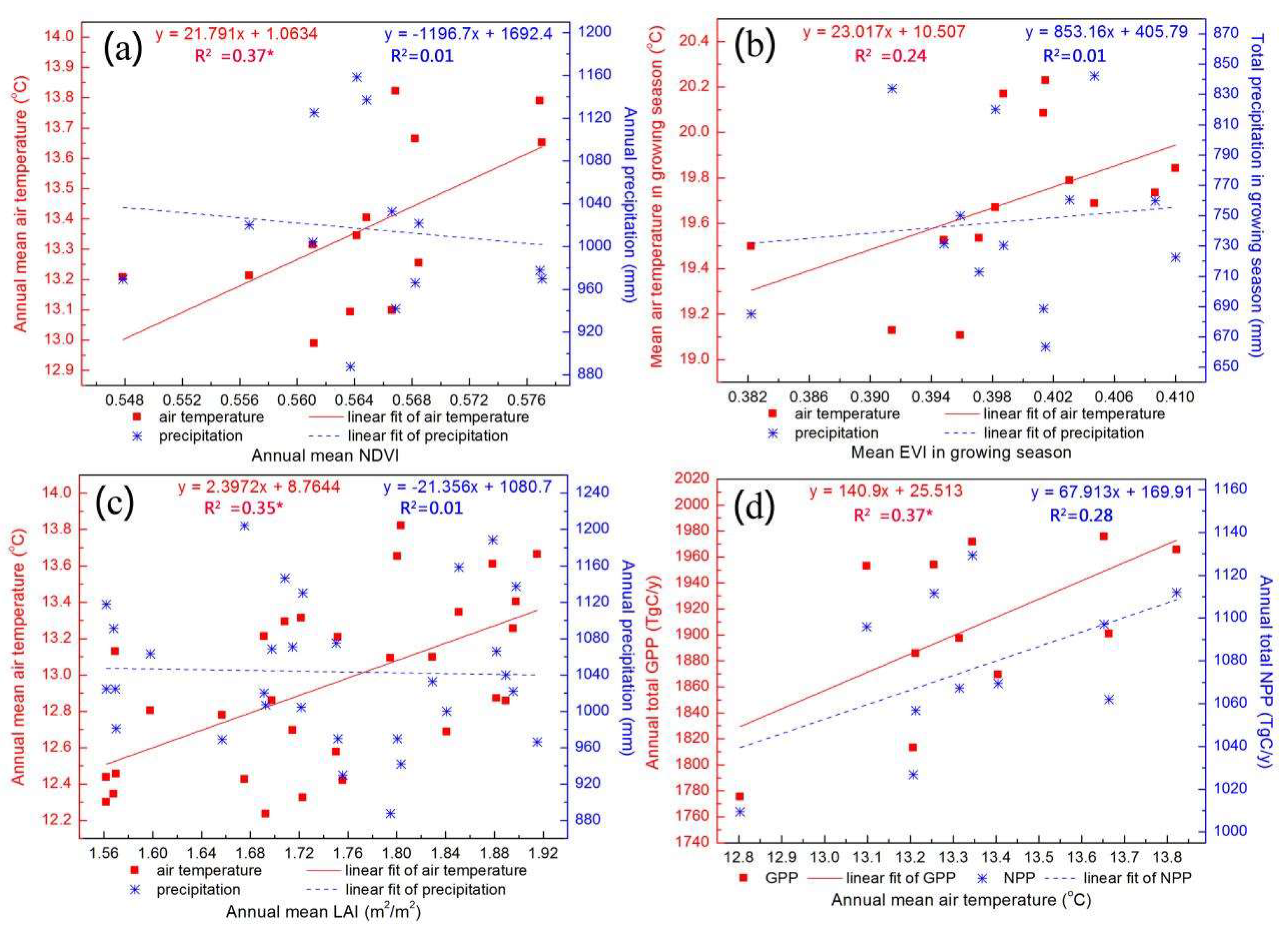
| Models | Resolution [lat (° N) × lon(° E] | Modeling Center/Group |
|---|---|---|
| CanESM2 | 64 × 128 | Canadian Centre for Climate Modeling and Analysis |
| CCSM4 | 192 × 288 | National Center for Atmospheric Research, United States |
| INM-CM4 | 120 × 180 | Institute for Numerical Mathematics, Russia |
| MIROC-ESM-CHEM | 64 × 128 | Model for Interdisciplinary Research on Climate, Japan |
| MPI-ESM-LR | 96 × 192 | Max Planck Institute for Meteorology, Germany |
| MRI-CGCM3 | 160 × 320 | Meteorological Research Institute, Japan |
| Data Category | Data Description | Interval | Source |
|---|---|---|---|
| Climate data | Daily mean temperature | 1961–2013 | China Meteorological Data Service Center (CMDC) (http://data.cma.cn/) |
| Daily precipitation | 1961–2013 | ||
| Ecological indicator | Normalized Difference Vegetation Index/Enhanced Vegetation Index (NDVI/EVI) | 2001–2013 | Moderate Resolution Imaging Spectroradiometer (MODIS) 13A1 product (http://ladsweb.nascom.nasa.gov/data/search.html) |
| Leaf Area Index (LAI) | 1982–2011 | Advanced Very High-Resolution Radiometer (AVHRR) at Boston University (BU) generated the Leaf Area Index (LAI) datasets (http://sites.bu.edu/cliveg/datacodes) | |
| Gross Primary Production/Net Primary Production (GPP/NPP) | 2000–2010 | MODIS 17A3 product (http://ladsweb.nascom.nasa.gov/data/search.html) |
| Variables | Increasing (slope > 0) | Decreasing (slope < 0) | ||||
|---|---|---|---|---|---|---|
| Total | p < 0.01 | p < 0.05 | Total | p < 0.01 | p < 0.05 | |
| Air temperature | 100.00 | 0.06 | 99.94 | - | - | - |
| Precipitation | 58.66 | 3.72 | 11.59 | 41.34 | 3.80 | 4.24 |
| Annualmean NDVI | 65.29 | 9.08 | 13.15 | 34.71 | 2.72 | 2.97 |
| Annualmean EVI | 60.23 | 9.04 | 10.15 | 39.77 | 3.71 | 4.08 |
| Annualmean LAI | 83.35 | 14.05 | 34.08 | 16.65 | 1.05 | 1.07 |
| Annual GPP | 70.04 | 4.20 | 2.79 | 29.96 | 0.27 | 0.37 |
| Annual NPP | 72.77 | 3.42 | 2.38 | 27.23 | 0.16 | 0.53 |
© 2018 by the authors. Licensee MDPI, Basel, Switzerland. This article is an open access article distributed under the terms and conditions of the Creative Commons Attribution (CC BY) license (http://creativecommons.org/licenses/by/4.0/).
Share and Cite
Chen, F.; Lin, A.; Zhu, H.; Niu, J. Quantifying Climate Change and Ecological Responses within the Yangtze River Basin, China. Sustainability 2018, 10, 3026. https://doi.org/10.3390/su10093026
Chen F, Lin A, Zhu H, Niu J. Quantifying Climate Change and Ecological Responses within the Yangtze River Basin, China. Sustainability. 2018; 10(9):3026. https://doi.org/10.3390/su10093026
Chicago/Turabian StyleChen, Feiyan, Aiwen Lin, Hongji Zhu, and Jiqiang Niu. 2018. "Quantifying Climate Change and Ecological Responses within the Yangtze River Basin, China" Sustainability 10, no. 9: 3026. https://doi.org/10.3390/su10093026
APA StyleChen, F., Lin, A., Zhu, H., & Niu, J. (2018). Quantifying Climate Change and Ecological Responses within the Yangtze River Basin, China. Sustainability, 10(9), 3026. https://doi.org/10.3390/su10093026





